Tour & Design
The Beyerdynamic DT 990 PROs are predominantly black over-ears with gray cup padding.
[
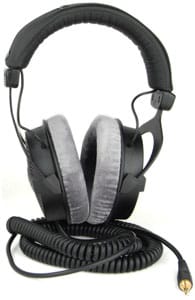
](https://reviewed.usatoday.com/headphones/images/upload/Image/Reviews/Beyerdynamic/DT_990_PRO/vanity-1000.jpg)
***In this image, the left cup has the band extended fully, while
the right cup has the band cinched closely (click for big pic).***
The outside of the ear cups is a series of slits that allow an open airway to the inside of the headphones. The white is a piece of cloth to help prevent gross garbage from getting inside your headphones.
[

](https://reviewed.usatoday.com/headphones/images/upload/Image/Reviews/Beyerdynamic/DT_990_PRO/side-2-1000.jpg)
***If you stare at these open backs long enough, you'll notice
the black oval in the middle makes them look like eyes,
in which case you'll probably feel a bit embarrassed for
staring in the first place (click for big pic).***
The cups are connected to each other with a wire that you can snake up and inside the head band's padding.
[

](../../images/upload/Image/Reviews/Beyerdynamic/DT_990_PRO/cup-1000.jpg)
Note the wire snaking around and into the band padding at right (click for big pic).
The headband itself is made of metal, and is wrapped in padding that snaps together in four places. The DT 990 PROs' cord is coiled, which does allow it to take up less space, but adds an annoying springiness for when you want to stretch it out.
You aren't getting much in the DT 990 PRO box, just some headphones and a 1/4-inch adapter.
[
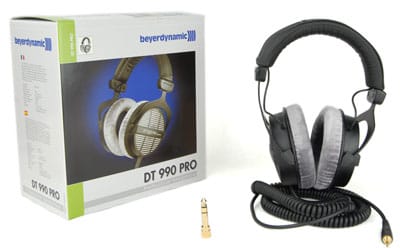
](../../images/upload/Image/Reviews/Beyerdynamic/DT_990_PRO/in-box-1000.jpg)
This is one of the most sparse 'In the box' photos we've taken to date. Enjoy your 1/4-inch adapter.
The DT 990 PROs seem really durable. The band has a metal core, which means these things aren't going to snap easily. The ear cups are junctioned to the band with plastic, but the union seems very robust. The cups themselves are big but seem to be well reinforced. Even the gills on the cups' backs don't have any give to them. The cups have a cloth padding, so that means you really don't have to worry much about piercing damage. The cord is thick and coiled and has really solid cord guards. We did have some concern with the cord's junction at the left ear cup, however, because the cord guard seemed like it could come loose easily.
The only other concern we had was regarding the cable that connects the two ear cups. Now, you can tuck it in the head band's jacket, but the cord is still exposed a bit. It also isn't as thick a gauge as the main cord. While the cable still seems robust, it does create a few more spots you'll have to be mindful of.
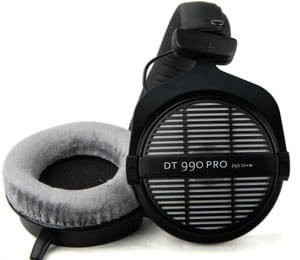
The DT 990 PROs are huge, which can look a bit silly, but overall we thought the DT 990 PROs looked nice. They have a nice, simple design that doesn't call oodles of attention but looks nice nonetheless. They look like they're expensive, but don't look overly youthful, which we consider a plus. These are headphones you could feasibly bring to work (keep the volume down though: [spoiler] they leak like crazy). These are the kind of headphones that some coworker will start a conversation with you about. 'Oh, Beyerdynamics... yeah, I got myself a pair of those Bose headphones and they're pretty good.' Respectible and good looking. We're fans of the DT 990 PROs, although those with smaller heads beware: a passerby will think your head is being swallowed by some horriffic monster.
Performance
About our testing:
We spared no expense when constructing our testing procedures in order to bring you the best science money can buy. Our opulent laboratory consists of two prized pieces of equipment: HATS and SoundCheck. HATS is shaped like a humanoid robot only with far better microphones in its ears than the average humanoid robot. HATS allows us to more accurately test how headphones will sound to a user. SoundCheck is an electroacoutsic analysis program that takes the data HATS gathers and spits out sharp-looking graphs. If you want to know more about our testing procedures, read this article.
**Frequency Response** *(8.33)* [

](https://reviewed.usatoday.com/headphones/content/How-We-Test-149.htm#Frequency_Response)
How the test works:
This test determines how much emphasis the headphones put on any given frequency. We put the headphones on HATS, then play back a frequency sweep from 100Hz to 20kHz. In this test, we play a range of frequencies through the headphones, into HATS's ears. HATS records the output, then sends it to SoundCheck, which compares the sound wave to the original. The graph below depicts how loudly each channel emphasized each frequency. The green line is the left ear cup; the red line is the right ear cup. The two dotted lines are the limits we score based on. If you'd like to read more information on this test, click the orange information icon to the right of this section's title, or underneath the graph at right.
What we found:
The Beyerdynamic DT 990 PROs had excellent frequency response. They boost bass ever so slightly, but the rest of the time they evenly emphasize sound. Towards the end the graph gets slightly more erratic, but manages to stay within the scoring limits. The 10kHz mark was ever-so-slightly overemphasized, but not by any great stretch. If you're looking for a dynamic response, you should look elsewhere. If you don't want your headphones tweaking your music for you, then the DT 990 PROs are an excellent option.
One thing to note about the graph at right: the left and right channels play almost the exact same emphasis. Typically one channel will be slightly louder at times or, on severely bad headphones, the two channels will veer off in wildly different directions.
How the Beyerdynamic DT 990 PRO compares:
The DT 990 PROs trounced just about all our comparison headphones. The SE-A1000s, which had a great frequency response, were the only challengers to even come close. The AH-NC732s, which are excellent active-cancellers, paled in comparison. Most of the over-ear headphones we've tested have been a bit erratic in their frequency response. While a dynamic frequency response is definitely preferred by some, the poor-scoring headphones below all underemphasized higher-end sounds by a significant amount. The DT 990 PROs don't have this problem. In fact, they really don't have any problems with frequency response.

](https://reviewed.usatoday.com/headphones/content/How-We-Test-149.htm#Frequency_Response)
How the test works:
Distortion refers to differences between the original sound file that is fed into your headphones and the sound they actually produce. We test distortion by playing back a frequency sweep and comparing the resulting sound to the original. On the graph below, the percentage of distortion runs down the Y axis while the range of tested frequencies stretch out along the X.
What we found:
The DT 990 PRO had virtually no distortion. There's not much else to say; the sound quality you'll get from these things is borderline pristine.
How the Beyerdynamic DT 990 PRO compares:
The DT 990 PRO has some stiff competition in this category, but manages to come in a very close second place. Realistically, however, the four headphones below with over 10 points would be utterly undescernable from each other. The Ultrasone HFI-2200s had a few issues with distortion, as did the Pioneer SE-A1000s. The HFI-2200s' distortion probably had something to do with their Natural Surround Sound feature creating artificial echoing in the lower end. The Pioneer SE-A1000s just had more distortion than the average set of headphones.

](https://reviewed.usatoday.com/headphones/content/How-We-Test-149.htm#Tracking)
How the test works:
Tracking is a measurement of relative volume. Whenever both channels are outputting similar volume levels, they have even tracking. What we're looking for here is any point where one channel is louder than the other. This, obviously, is bad. On the graph below, when the line goes above zero it means the left channel is louder. When the line drops the right channel is louder.
What we found:
The DT 990 PROs had even tracking for the most part, but towards the high end the tracking gets a bit screwy. Tracking typically goes a bit haywire towards the high end, but typically that doesn't happen until after 10kHz. The shift isn't astronomical, so chances are you won't really notice it. Overall, the headphones did very well.
How the Beyerdynamic DT 990 PRO compares:
The DT 990 PROs had a middling tracking score relative to our comparison headphones. The Pioneer SE-A1000 only had small shifts from left to right and the Ultrasone HFI-2200s remained relatively flat until it was out of our scoring zone (lucky, that). Again, this score is based on the largest shift exhibited; emphasis that slowly meanders from the left channel to the right won't be noticeable.
**Maximum Usable Volume** *(5.79)* [

](https://reviewed.usatoday.com/headphones/content/How-We-Test-149.htm#Maximum_Usable_Volume)
How the test works:
Maximum usable volume refers to the highest decibel output the headphones are capable of without exceeding 3% distortion. Once you've hit this level, boosting the volume any more will cause significant harm to your audio quality. We arrive at this decibel threshold by running a series of distortion tests at increasing volume levels.
What we found:
The DT 990 PROs were capable of an average output: 102.33dB. This isn't a bad output for a set of open-backed over-ears, because if you're using them, you're probably in a quiet enough environment.
We award maximum points to 120dB of output, but any more than that is dangerous and we simply can't recommend it. If you even go over that limit by a tenth of a decibel, we will send a note to your parents.

](https://reviewed.usatoday.com/headphones/content/How-We-Test-149.htm#Isolation)
How the test works:
What we found:
No surprises here. The DT 990 PROs are open-backed headphones, so they don't isolate particularly well. If you're going to be in noisy environments, toss on a pair of in-ears or active noise cancellation headphones. We were actually surprised at how little noise these headphones blocked out; you won't notice much of a difference between wearing them and taking them off.
How the Beyerdynamic DT 990 PRO compares:
The DT 990 PRO actually doesn't lose this comparison, since there are many other open-backed headphones listed below. Surprisingly, the DT 990 PROs blocked out more sound than their open-backed brethren. It lost to the ATH-A700s, which are closed-back over-ears. The Denon AH-NC732s are active noise cancelling headphones, so they of course trounced the competition. Again, if you're looking for headphones to take with you on your commute, do not get open-backed headphones like the DT 990 PROs. Stick with in-ears, like the Shure SE420s or active-cancellers like the Denons.

](https://reviewed.usatoday.com/headphones/content/How-We-Test-149.htm#Isolation)
How the test works:
Leakage refers to how loud your muic will sound to someone standing close by. Since these are headphones and not gigantic 80s-era boomboxes, quiet headphones get the most points. We test leakage by piping pink noise through the headphones while a microphone a few inches away listens.
What we found:
Again, not a surprising result. The DT 990 PROs did not have good leakage control. If you need to keep quiet, they aren't the headphones for you. Even at a moderate volume a neighboring cubicle could hear your playback. Again, this poor score is relatively meaningless for a pair of over-ears: they're meant to be used in a personal listening environment, where disturbing others is not a concern. If you want to keep your music private, your best bet is a set of in-ears.
In Use
These headphones are ridiculously comfortable for a set of over-ears. The padding feels like it was made from Beanie Baby pelts. The things fit well, not crushing our delicate, grape-like head or sliding around with the slightest tilt or nod. Clearly, they're big and open-backed, so you wouldn't be taking these on a run, but if you did the DT 990 PROs probably would slide around quite a bit. We really don't have many complaints reguarding comfort.
All this being said, pretty please try these things on before you buy them. If that's not an option because the store has a dumb policy about your lice infestation, then the first thing you should do is settle down for a long listening session. If you don't like them, return them. Our comfort level is entirely subjective and, in all liklihood, different than yours.
We didn't run into any comfort issues after wearing these things for 6+ hours. The band's padding kept it from feeling like it was made of metal, the pads on the ear cups were soft enough so they didn't feel like too much pressure... these are very wearable headphones.
**UPDATE: **After using the DT 990 PROs for a while, we had to update this score. Although they were very comfortable initially, the DT 990 PRO's top band can quickly become uncomfortable with repeated use. Afer a week or so of near-constant use, we noticed the band started to feel less and less comfortable after a few hours.
**Cable Connectivity***(12.57)*
Measuring cable length was a bit difficult since it's coiled. What we did is measure the point at which the tension of the cord's springiness makes wearing the headphones uncomfortable. We were able to stretch the DT 990 PROs a full 10 feet away from its cord, making them absurdly easy to hook up just about anywhere. Any further than 10 feet and you'll have to fight the headphones as they attempt to flee your head.

***Other than a robust cord guard, there's nothing
particularly speacial about the DT 990 PROs' plug.***
Also included: a 1/4-inch adapter that screws onto the 1/8-inch plug. This is a great inclusion for people with fancy pants amps. The screw-on aspect is also excellent because without it, the 1/8-inch plug probably wouldn't stay put for long.
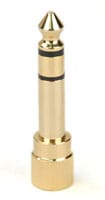
***The inside of this adapter is threaded
so you can screw it onto your headphones.***
Like most over-ears with leagues-long cords, the DT 990 PROs aren't very portable. First of all, they're gigantic. Second of all, their cord is very long and very thick. Its coils don't allow for easy management; you couldn't just shove the excess in your pocket comfortably. You also shouldn't be taking these anywhere because of their open backs. Open-backed headphones don't have much of a barrier between the outside world and your soundstage, meaning everyone can hear your music and you can hear whatever other people are doing. This is a bad situation because you might feel inclined to bump your volume to overcompensate, making your ear drums explode like a claymore mine. Those around you will also have to put up with whatever horrible music you were listening to. Keep your ear drums safe and avoid annoying the general public by keeping your DT 990 PROs at home.
The DT 990 PROs don't have much in the way of customization. You can adjust the band's length and you can swivel the cups around a bit, but there's not much else to do. Some headphones come with removeable faceplates or other little trinkets you can bedazzle your headphones with. Sadly, this is not the case with the DT 990 PROs.
The DT 990 PROs aren't the easiest to maintain headphones we've seen. You can take off the ear cups, but once you do you're presented with some sort of plastic puzzlebox that doesn't open easily. We didn't want to outright break our review unit, so after a few minutes of trying to pry the center piece away from the headphones we gave up. We might update this section at a later date if we get a pair of these for the office, because we have no qualms about outright destroying things we've paid our own money for.
[

](../../images/upload/Image/Reviews/Beyerdynamic/DT_990_PRO/pad-off-1000.jpg)
Taking off the cup padding isn't particularly illuminating.
**Other Features***(5.00)*
Battery Dependency
The DT 990 PROs do not require batteries to run. You are free to listen to music for as long as your device has a battery charge.
Value & Comparisons
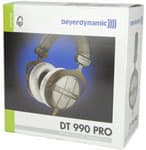
Value*(4.00)*
While the DT 990 PROs have a steep MSRP, $300, but you can easily find them for $260 or less online. We think the cost is relatively appropriate for what the DT 990 PROs provide. Sure they're expensive, but they're great, so it evens out a little. The DT 990 PROs are an excellent set of over-ears at an appropriate price. Many over-ears out there hope to attain a sort of psycho-acoustic placebo effect through pricing, but fortunately this isn't the case for the DT 990 PROs.

[

Denon AH-NC732](https://reviewed.usatoday.com/headphones/content/Denon-AH-NC732-Headphones-Review-653.htm) - The Denon AH-NC732s are a great pair of headphones, but they're meant for an entirely different environment than the DT 990 PROs are. If you're planning on going outside, the Denons should be your choice hands-down. The AH-NC732s are more meant to be appropriate both at home and on the go, hence their active cancellation. If you're staying inside, the DT 990 PROs are better by a landslide. They're more comfortable, have better overall audio quality, and better connectivity.
[

Pioneer SE-A1000](https://reviewed.usatoday.com/headphones/content/Pioneer-SE-A1000-Headphones-Review-312.htm) - The Pioneer SE-A1000s are a decent set of over-ears, but the DT 990 PROs just outmatch them in just about every way. The SE-A1000s might appeal to those looking to spend a bit less money, since they cost $200, but for the extra money the DT 990 PROs offer a slightly better deal and much better audio quality. Unless you're strapped for cash (in which case you really shouldn't be considering the SE-A1000s anyway, they're a bit overpriced), pick up the DT 990 PROs.
[

Sennheiser HD 555](https://reviewed.usatoday.com/headphones/content/Sennheiser-HD-555-Headphones-Review.htm) - The Sennheiser HD 555s have a lot of good qualities. They have a good sound, low distortion, are comfortable, and very inexpensive -- you can find them for under $100 now. The HD 555s are definitely a better pair of entry-level over-ears. The DT 990 PROs, on the otherhand, have much better audio quality, are more comfortable, and cost a lot more money. If you're just getting into headphones, we'd recommend trying out the HD 555s. If you want to make a bigger investment, there's really no reason not to spring for the DT 990 PROs.
[

Audio-Technica ATH-A700](https://reviewed.usatoday.com/headphones/content/Audio-Technica-ATH-A700-Headphones-Review-645.htm) - Even on the low side, the DT 990 PROs cost twice what the ATH-A700s do. The ATH-A700s are good headphones, but they don't perform quite up to where their price point has put them. This is another issue of price and value. The ATH-A700s have a lower price, but they are still over-priced for what they give you. The DT 990 PROs cost a lot more, but also perform a lot better. This match-up is a lot like the SE-A1000s match-up: if you're a budget buyer, get the Sennheiser HD 555s, not these. If you're looking for quality, get the DT 990 PROs.
[

Ultrasone HFI-2200](https://reviewed.usatoday.com/headphones/content/Ultrasone-HFI-2200-Headphones-Review-482.htm) - The HFI-2200s have an interesting sound that we didn't particularly like. They didn't do all that well on our audio tests and weren't particularly comfortable. This being said, you should try them on to see if you personally like the sound. They cost about as much as the DT 990 PROs, priced pretty close to $275. Although our scoring system says you should pick up the DT 990 PROs hands down, you should listen to both before making a decision.
Also, the coloration reminds us of carpeting from the 70s.
Conclusion
Conclusion

We're totally sold on the Beyerdynamic DT 990 PROs. These things have a great sound, excellent sound quality, are very comfortable, and have a long cord. The giant, open-backed cups give a very immersive soundstage. We also think they look good as well. If you're looking for at-home headphones, the DT 990 PROs are a great option. We highly recommend these.

Really low distortion and a flat frequency response will definitely appeal to audiophile purists who don't like their headphones screwing around with their music. Highly recommended here.
Stick with in-ears.
Not only are these not portable, but the lack of isolation and leakage means you'll be making yourself and the person next to you deaf.
Home theater is a great environment for the DT 990 PROs. They won't have the meatiest explosions or as many options as a set of over-ears that are specifically meant for movie viewing, but they'll provide a huge soundscape that will really help portray a large sense of scale.
Meet the tester
Mark Brezinski works on the Home Team, reviewing refrigerators, minifridges, dishwashers, washing machines, dryers, air conditioners, air purifiers, and fans.
Checking our work.
Our team is here for one purpose: to help you buy the best stuff and love what you own. Our writers, editors, and lab technicians obsess over the products we cover to make sure you're confident and satisfied. Have a different opinion about something we recommend? Email us and we'll compare notes.
Shoot us an email
